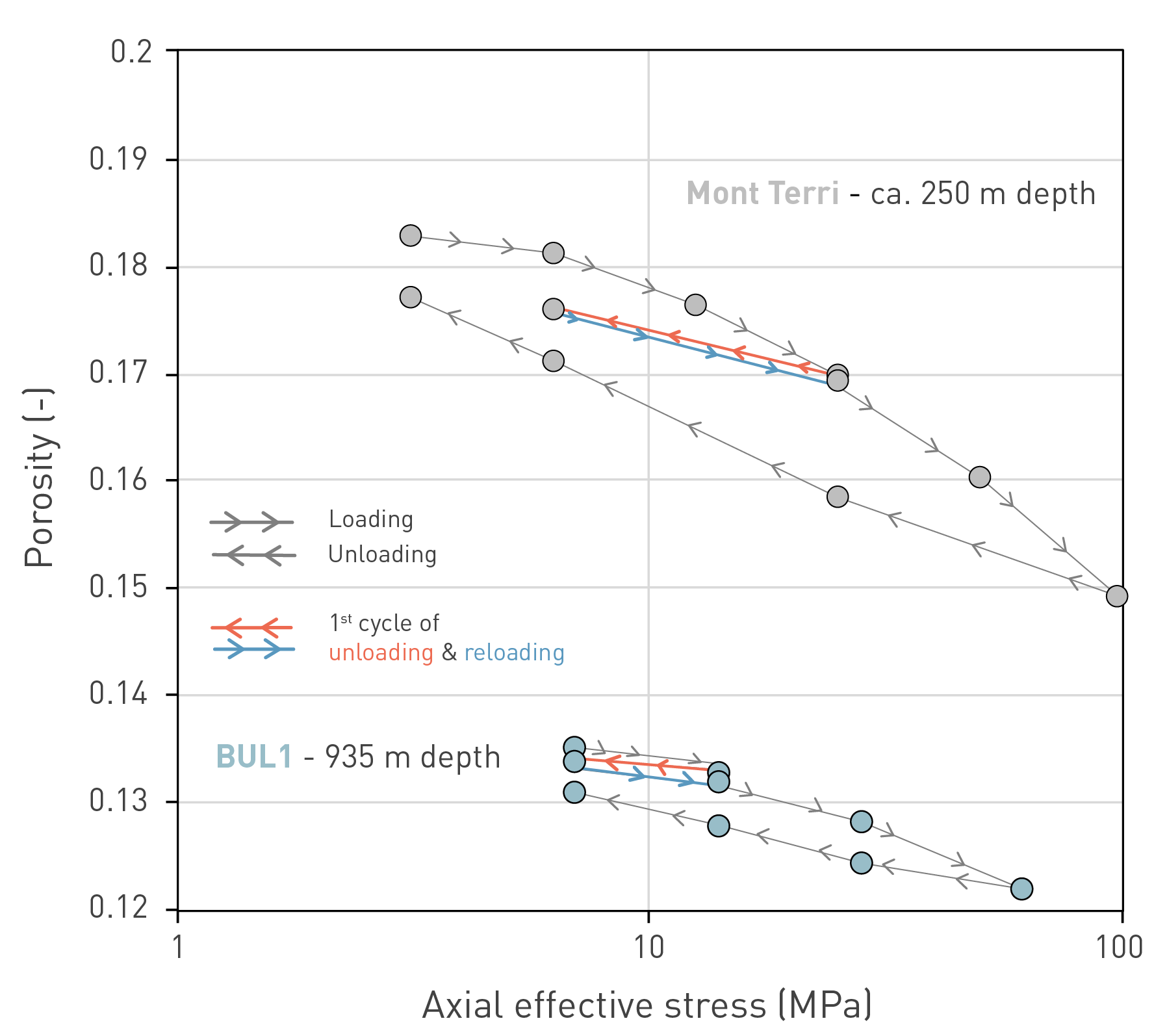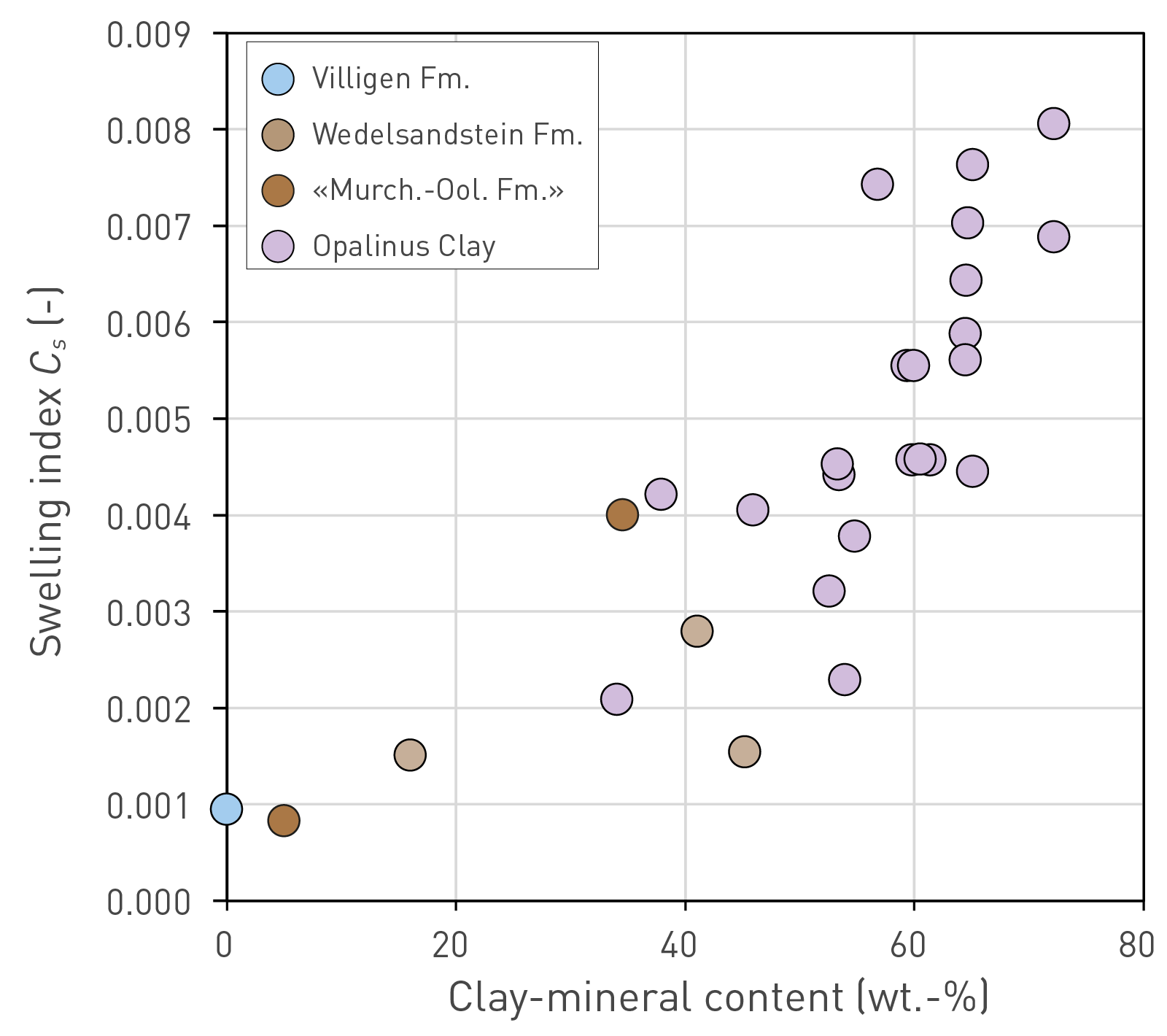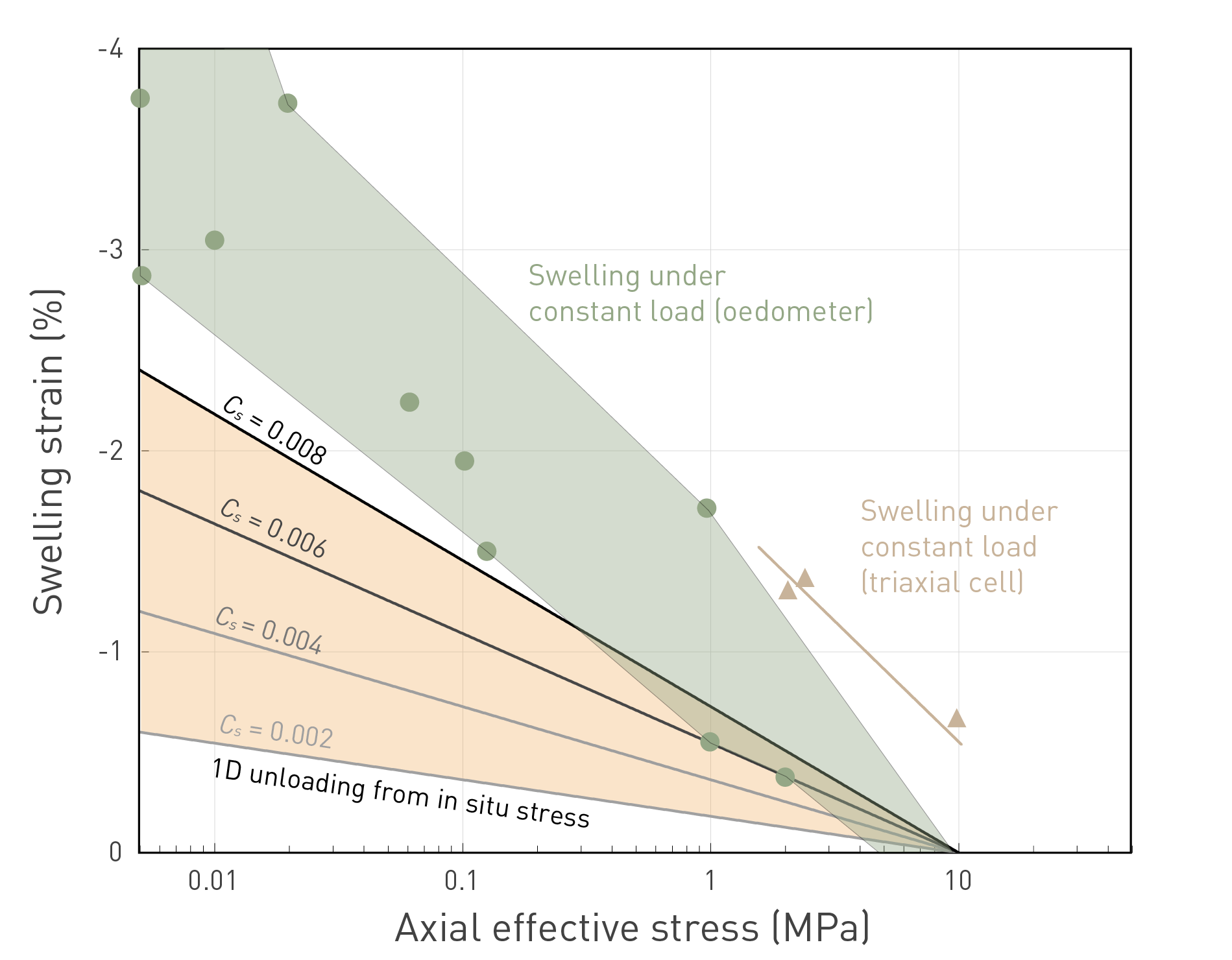Geomaterials subjected to load change experience deformation, either volumetric and/or distortional. When compressed, the Opalinus Clay experiences both irreversible and reversible volumetric deformation. After loading and unloading, a part of the deformation is recovered in an elastic rebound (Fig. 5‑21 in Section 5.5.3). The amount of plastic (irreversible) and elastic (reversible) deformation can be investigated in oedometric tests: a cylindrical sample is loaded in the axial direction, while radial strains are prevented (i.e. the specimen can only experience deformation in the loading direction) and porewater pressure is maintained.
Two curves obtained from oedometric tests in saturated conditions are reported in Fig. 5‑21, one for the Opalinus Clay from the Mont Terri rock laboratory, and one from the BUL1 borehole. Both samples have a similar clay-mineral content (ca. 60 wt.-%), and the main difference between the two is the depth of extraction and porosity at the start of the tests. Initially, the sample is saturated in constant volume conditions (total stress is increased to constrain the swelling and keep deformation close to zero). Afterwards, samples are always kept saturated. The porosity evolutions with the load/unload increments are shown as a function of applied axial effective stress. Effective stress is defined here as the difference between the total stress (because of external loads) and the porewater pressure.
Each point corresponds to a loading (or unloading) step, where load is applied (or removed), and the evolution of axial displacement is measured. The evolution of the displacement is related to the porewater pressure build-up or reduction (depending on whether a load is applied or removed) and its dissipation in time. The response of a material is related to its hydromechanical properties, particularly the hydraulic conductivity, and its rigidity (through the oedometric modulus); these two properties combined define the consolidation coefficient. At the end of the porewater overpressure dissipation, the sample is consolidated, and the corresponding porosity is assigned to that stress level (i.e. the points on the curve represent drained states). If the load is maintained beyond the time needed for the sample to consolidate, viscous deformation at constant load can be observed, referred to as secondary compression ("creep"). During the experiments, the extent of the creep deformation is usually minor compared to the amount of deformation due to changes in effective stresses.
While the overall response is similar, it is noted that the Opalinus Clay at Mont Terri shows generally higher porosity and higher compressibility (expressed by the slope of the curve upon loading at high stresses) within the investigated range of stress.
The unloading paths (highlighted in Fig. 5‑21) allow calculation of the swelling index, Cs. It is worth highlighting that "swelling index" is a geotechnical term that indicates the slope of the unloading branch in oedometric conditions in the semi-logarithmic void-ratio (equivalent to porosity used in Fig. 5‑21) versus vertical effective stress plane. This is related to the elastic properties of the saturated material upon unloading, and it is not to be confused with the swelling related to the saturation process. The higher the swelling index, the steeper the curve in the plot. A high swelling index corresponds to low stiffness and vice versa.

5‑21: Comparison of oedometric curves of the Opalinus Clay from Mont Terri and BUL1
Note that both samples have a similar clay-mineral content of approximately 60 wt.-% but a different initial porosity. The unloading path (adopted to calculate the swelling index Cs) is highlighted.
For geomaterials with a comparable range of porosity, a high Cs (i.e. low stiffness) is obtained for a high clay-mineral content. On the other hand, for low clay-mineral content material (< 40 wt.‑%), the effect of the composition on the stiffness is limited, and additional aspects such as the porosity play a major role for the observed stiffness.
Obtained swelling indices from testing Opalinus Clay and confining units are summarised in Fig. 5‑22 as a function of the clay-mineral content. The Cs are computed for unloading from stress levels of 20 – 15 MPa, down to a few MPa, and show a positive correlation with clay-mineral content. The upper limit of the stress range adopted for Cs calculation was chosen to be comparable with the expected maximum stress experienced by the formation.
In conventional unconstrained swelling tests (ISRM 1989, VSS 2019), axial swelling is measured on samples which are initially not fully saturated with water. Due to this partial saturation, such samples can experience a considerable amount of suction (equivalent to negative porewater pressure), resulting in strong hydraulic head gradients when the samples are exposed to water, and increased effective stress compared to fully saturated samples with positive porewater pressures under similar confining stress. Total expansion in such tests may therefore be greater than that measured in the unloading tests. For comparison of the two methods, a number of swelling tests were also done by starting from unsaturated conditions and a specified controlled load to assess the expansion over the low effective stress range (Fig. 5‑23).

Fig. 5‑22:Swelling index (Cs) as a function of the clay-mineral content
Values obtained from the unloading paths from 20 – 15 MPa, down to a few MPa (drained, saturated conditions). Fm.: Formation.
In such swelling tests under constant load, the following procedure was adopted. The initial sample saturation is "as prepared". A constant stress level was then applied to samples and, afterwards, the sample was put in contact with balanced porewater and allowed to swell under constant load.
The specimens first may undergo a compression because of the load applied, then an expansion because of the saturation (i.e. effective stress reduction). The stresses shown in Fig. 5‑23 are those achieved at the end of the swelling phase, and the strains reflect the difference from the maximum compression (initial load) to the maximum expansion at the end of the test. At an axial effective stress of approximately 5 to 10 MPa, the swelling under constant load did not result in any relevant net swelling strain. Swelling under constant load was also examined under triaxial conditions (Crisci et al. 2024a) and resulted in similar slopes (swelling strain vs. logarithmic axial effective stress) as in oedometric conditions (Fig. 5‑23).
The 10 MPa axial effective stress can be considered equivalent to a depth of approximately 700 m (in situ). Assuming the range of determined Cs values of Opalinus Clay (Fig. 5‑22), typical unloading paths from saturated conditions are also plotted in Fig. 5‑23. These indicate the amount of swelling strain for a specific axial effective stress starting from the assumed 10 MPa in-situ vertical (axial) effective stress.

Fig. 5‑23:Axial swelling strain in the Opalinus Clay constrained by different methods
Orange surface indicates range of swelling strains (negative values for expansion) from saturated conditions at an assumed in-situ axial effective stress of 10 MPa (equivalent to approximately 700 m depth), with Cs (swelling index) values from Fig. 5‑22). Swelling from initially unsaturated conditions at constant load are also shown for comparison (both from oedometric tests and also trends from triaxial tests), with each data point reflecting a separate test. Note the even larger expansion for swelling tests at constant load.
Swelling under constant load shows greater overall swelling strains than unloading from saturated conditions, with one data point even plotting outside the limits of the graph (swelling strain of 5.6% at 0.05 MPa axial effective stress). Previous results of unconstrained swelling tests (also starting from unsaturated conditions) from the Benken (Nagra 2002) and Schlattingen boreholes (Ferrari et al. 2012) are also consistent with the new results, with swelling heaves up to 11%. For the very low effective stress range (< 1 – 3 MPa), swelling may induce microfissuring, i.e. enhancing the expansion (for the mechanism, see Section 5.7.3), compared to the saturated unloading.
In summary, the swelling capacity of the Opalinus Clay was assessed using different methods, and under various conditions and hydromechanical stress paths. All the methods highlight significant expansion, with most of that expansion occurring at very low or negligible effective confinement.

